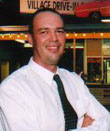|
|
This topic comprises 3 pages: 1 2 3
|
|
Author
|
Topic: Drive In / Outdoor Screen Material
|
|
|
|
|
Jack Ondracek
Film God

Posts: 2348
From: Port Orchard, WA, USA
Registered: Oct 2002
|
 posted 08-18-2004 09:55 PM
posted 08-18-2004 09:55 PM





You'll still find a lot of wooden screens in parts of the US. There's one about an hour from me that is built from plywood sheeting over a wooden frame. It's been there for 50 years, though it doesn't face very extreme weather. There's one in Florida that's made of concrete block (it's still standing, by the way).
As David says, a steel screen is probably the best way to go... unless you're trying to do it yourself. However, on the subject of reflections caused by moisture, my experience is that a flat surface that attracts moisture can be reflective, regardless of paint. One of my screens faces the prevailing winds, and is a real problem in that regard. The screen's angle to the viewing audience is also a major factor.
Jerry Selby (of the screen company) has said that the "wavey" type of corrugated roofing metal works well for screen surfaces that face this problem, because only a small part of the surface is directly in line with the audience at any given point. If rain does hit the screen, those parts of the corrugations that are not in direct line with the viewer will act as a diffuser of sorts, minimizing any reflective effect. This material also works well in wide viewing angle situations.
In practice, I also have such a screen. My original 1949 screen has been refaced with 2X24' strips of corrugated steel. You can't see the waves unless you're within 20 feet of the screen and the picture is bright and uncluttered. I use the same paint on that screen that I use on my "problem" one, yet the corrugated surface never exhibits any reflection issues.
So... there are several ways to skin the cat. Local conditions and how long you expect to be in the business are probably the major considerations when selecting materials.
[ 08-19-2004, 03:32 AM: Message edited by: Jack Ondracek ]
| IP: Logged
|
|
|
|
|
|
|
|
|
|
|
|
|
|
|
|
|
|
|
|
Stephen Furley
Film God

Posts: 3059
From: Coulsdon, Croydon, England
Registered: May 2002
|
 posted 08-22-2004 03:18 AM
posted 08-22-2004 03:18 AM




I've never seen I drive in, I don't think we ever had a permanent one here, but I do have a Super-8 print of an old Pathe Pictorial about one in Rome. There was a mention of being able to sit outsde, I think it was at tables rather than on the ground, to watch the film, but "you can only hear it from the comfort of your car" Not much point in that then, is there. When I first bought the film, at a collectors' fair, I actually had to watch it without sound, as it has an optical track, and I only had a magnetic projector at the time.
Sound, mono of course, was from small speakers hung on columns by each car, that you unhooked, and brought into the car, along wth a heater, if required.
What possible advantage any of this could have over a normal cinema, I cannot imagine. The narrator was very enthusiastic about it all, and predicted that, hopefully, one will be openiing near you very soon. Well, something over forty years later, there still hasn't been one anywhere near me.
We have had outdoor film shows here from time to time, Crystal Palace Park in South London is one place I can think of, but these are rare events, and are sit down on the grass, or deck chairs, not for cars. I've never been to one of these, but I did once see one being set up. The screen had not been errected, so I don't know what type it was, there was a large pile of speakers at each side, but no sign of anything in the centre. I think the projectiion was from inside a truck.
The Pathe Pictorial is quite an interesting little film. I've no idea who holds the rights to it now, I wonder if it would be possible to reproduce it for a reasonable fee.
| IP: Logged
|
|
Jack Ondracek
Film God

Posts: 2348
From: Port Orchard, WA, USA
Registered: Oct 2002
|
 posted 08-22-2004 03:55 AM
posted 08-22-2004 03:55 AM





Josh:
Many early drive-ins were built with playgrounds in front of the screen. It gave the kids something to do while waiting for the show to start. As drive-ins pretty much all had a fair amount of unused land in front of their screens, playgrounds were common. In many of the drive-ins left today, that area is a popular picnic spot. Insurance requirements and the fear of general liability has resulted in a lot of that equipment being removed in the drive-ins that remain in this country.
Drive-ins never had speakers behind their screens... as far as I know. The very first ones did have speakers under them however, making the theatres very poor neighbors. Some drive-ins installed speakers under the ramps... which didn't work all that well, either. Until the mid '80's, sound was transmitted to cars by way of speakers mounted on poles next to the cars. Eventually, AM radio... then FM stereo became commonly available to drive-ins, which was a good thing, because most people had better sound systems in their cars than they had in their homes.
This comes back to your question about sound in front of the screen for pic-nickers. As many drive-ins now have radio sound, all they need is their own car or portable radio.
Stephen:
It's not surprising you haven't run into a drive-in. They're mainly an American phenomenon, and something of a curiosity in other countries. After WWII, America literally fell in love with their cars. We had a new interstate freeway system in place... or in construction, and people started going everywhere in their cars... including an eventual move away from travel by train. Many businesses catered to this popularity, including drive-up restaurants... and drive-in theatres. Some sources say we had well 6,000 of them at one time.
| IP: Logged
|
|
|
|
|
|
All times are Central (GMT -6:00)
|
This topic comprises 3 pages: 1 2 3
|
Powered by Infopop Corporation
UBB.classicTM
6.3.1.2
The Film-Tech Forums are designed for various members related to the cinema industry to express their opinions, viewpoints and testimonials on various products, services and events based upon speculation, personal knowledge and factual information through use, therefore all views represented here allow no liability upon the publishers of this web site and the owners of said views assume no liability for any ill will resulting from these postings. The posts made here are for educational as well as entertainment purposes and as such anyone viewing this portion of the website must accept these views as statements of the author of that opinion
and agrees to release the authors from any and all liability.
|

 Home
Home
 Products
Products
 Store
Store
 Forum
Forum
 Warehouse
Warehouse
 Contact Us
Contact Us




 Printer-friendly view of this topic
Printer-friendly view of this topic









![[Smile]](smile.gif)





